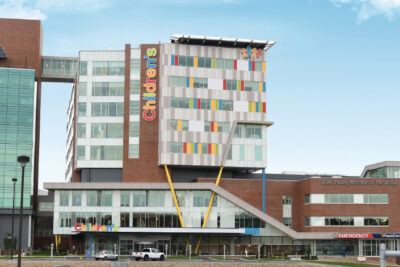By Cathy Bonnstetter

Albert Wright Jr., president and CEO of the West Virginia University (WVU) Health System, came to the Mountain State in 2014 prepared to grow the health care network, which is now the largest one in the state, to include all West Virginians—even the smallest ones.
During his first week at the helm of the WVU Health System, Wright toured the children’s hospital, which was actually a hospital within the hospital on the sixth floor of the WVU Ruby Memorial Campus in Morgantown. After that tour, Wright decided that these young patients, their families and the medical professionals who cared for them deserved their own space, designed specifically for their needs—a space designed to make this hospital experience just a little bit easier for families and children.
Wright put the wheels in motion and persevered through a pandemic, significant inflation, supply chain shortages, staffing shortages and even national hospital closing trends. Eight years later, on September 22, 2022, the first patient was wheeled from Ruby Memorial Hospital to the brand new, free-standing WVU Medicine Children’s Hospital—by design, a child-loving, family-friendly facility.
“WVU Children’s Hospital is one of those hospitals you build hoping people will never need, but it’s there when they do need it,” Wright says. “We had challenges that delayed the project a little, but we had a plan, and we opened a beautiful hospital that is functioning well.”

The goal of the 150-bed hospital is to give all West Virginia families the best treatment possible so they do not need to leave the state to find care. Wright knows from experience how important it is to families to find proper care that is convenient and close to home.
“I am the father of a child who spent time in a neonatal intensive care unit (NICU), and I am the father of a child who needed major surgery,” he says. “When you have a sick child, it throws your life upside down.”
With 90 specialist providers, WVU Medicine Children’s Hospital offers the entire range of specialties in pediatrics. In fact, the hospital hosts the only pediatric cardiac surgery program in the state. Every hospital room is equipped with cardiac monitoring capability so that patients do not need to be moved should they develop a need for cardiac care during their stay.
The hospital also houses the state’s only level four NICU, the highest level of care for these patients. In addition, the hospital offers a complex neurosurgical program, including brain surgeries and an epilepsy monitoring unit equipped to serve children, and a 27-bed pediatric intensive care unit.
“We are the only health care system in the state that does several things,” Wright says. “We work hard to keep viable programs to make sure children in the state who need them can get them here.”
WVU Medicine Children’s Hospital also offers high-risk maternal and gynecological care. The hospital is physically attached to Ruby Memorial Hospital. This arrangement is designed so that patients can flow between the two hospitals if needed, rather than be transported by ambulance and separated by miles.
Not only does the hospital offer state-of-the-art care, it also offers families comforts that can make big differences during stressful times. At WVU Medicine Children’s Hospital, every room, including the NICU rooms, is designed so that parents can stay with their sick child. Wright says this arrangement in neonatal intensive care is almost unheard of, but in West Virginia, logical and necessary. All the rooms have showers, team areas, patient areas and family areas with couches that pull out into beds and closet space.
“We are a rural state, and some people come from Ripley or Charleston,” Wright says. “A hotel is expensive. Mom and Dad can stay for free at the hospital and be with their sick child.”
The entire hospital design is conducive to family healing and health. Amy Bush, chief administrative officer for WVU Medicine Children’s Hospital, explains that just as there is evidence-based medicine—medical care that emphasizes the practical application of research findings—there is also evidence-based design.
“We call it the healing environment,” she says. “Access to light and nature, noise control and the ease of finding your way around are part of that. All the non-clinical things you also associate with a hospital—the gift shop, the family resource center and cafeteria—are here with a pediatric theme. We want to create an environment for patients and families that is as homelike as possible. This helps to decrease anxiety and stress, which helps promote healing. Private rooms also help reduce the spread of germs. We wanted our environment built so that our care team members can care for kids in a manner that is of the highest quality, safety and efficiency so we can get kids back home. We want the best environment for our team to work in as well.”
The hospital’s care for and impact on families is not limited to what is contained within its walls.
“WVU Medicine Children’s Hospital is our hospital in Morgantown, but WVU Medicine Children’s is really throughout the state and region in all of our clinics and health system,” Bush says. “Whether it is our pediatricians working primary care or prevention or our specialists seeing kids in the communities before or after surgery, we want to be partners with the hospitals within our system in West Virginia and the surrounding regions, as well as with the pediatricians and specialty clinics we set up. We also partner with a number of hospitals to help their pediatric units and their newborn nurseries at these hospitals.”
WVU Health System’s patients are connected to all the clinics and hospitals with an electronic medical record so that if patients need to travel within the system to a specialty clinic the continuity of their care is seamless.
“If a child needs our care, whatever the setting might be—in the hospital, the ER, the outpatient clinics or the community—it is all about building healthier futures and delivering the best outcomes,” Bush says.
Wright says that the hospital’s reach goes even beyond the clinics and communities, right into patients’ homes with telehealth capabilities.
“There aren’t a lot of silver linings that came out of COVID,” Wright says. “But the embracement of telehealth and telemedicine is one of them. Behavioral health especially lends itself exceptionally well to telemedicine, and we have some significant behavioral health challenges around the state with families torn apart by the opioid epidemic. Telemedicine increases access in a rural state, and it provides a relaxed setting for the caregiver and patient. I am very proud of our behavioral health providers. They have really embraced telehealth and made it a win-win.”
The new children’s hospital also means new opportunities for people in the community and economic boosts for the state. The hospital’s payroll dedicated to children has more than doubled since its opening, going from 500 staff members to just above 1,000 staff members.
Bush says the new hospital also makes recruiting physicians, surgeons and staff an easier task. WVU Medicine Children’s Hospital was the result of dogged determination, meticulous financial planning and the generosity of many donors.
“We try to control our expenses and live within our means,” Wright says. “We are not flush with pots of gold, but we were able to stow away enough to build the hospital. We also have some very generous donors, and they contributed about $80 million toward the project.”
While Wright’s packed schedule leaves him busy, the day the children’s hospital opened caused him to pause and reflect on the importance of this work.
“I believe the Children’s Hospital will be one of our legacy projects for the foreseeable future,” he says. “We take our responsibility as the largest health care provider in the state very seriously, so we have to stay disciplined in our spending every day. But when the children’s hospital opened, it was a special day for me and quite gratifying.”
Bush, whose credentials include a bachelor’s degree in nursing, an MBA and Certified Nursing-Operating Room certification, joined WVU Medicine in 2015 as the vice president of operations. Although she has been involved with many expansive hospital initiatives, she agrees that opening a place that can give families so much hope fills her heart.
“When Albert asked me about leading this project, I thought this is it, a once-in-a-lifetime chance to be part of a legacy with a team that is going to help people for generations to come,” she says. “I am passionate about helping to make a difference, and it is so important to have people not need to travel for their health care. I tell people the top five experiences in your lifetime are different personally and professionally, but this is right at the top of both for me.”







